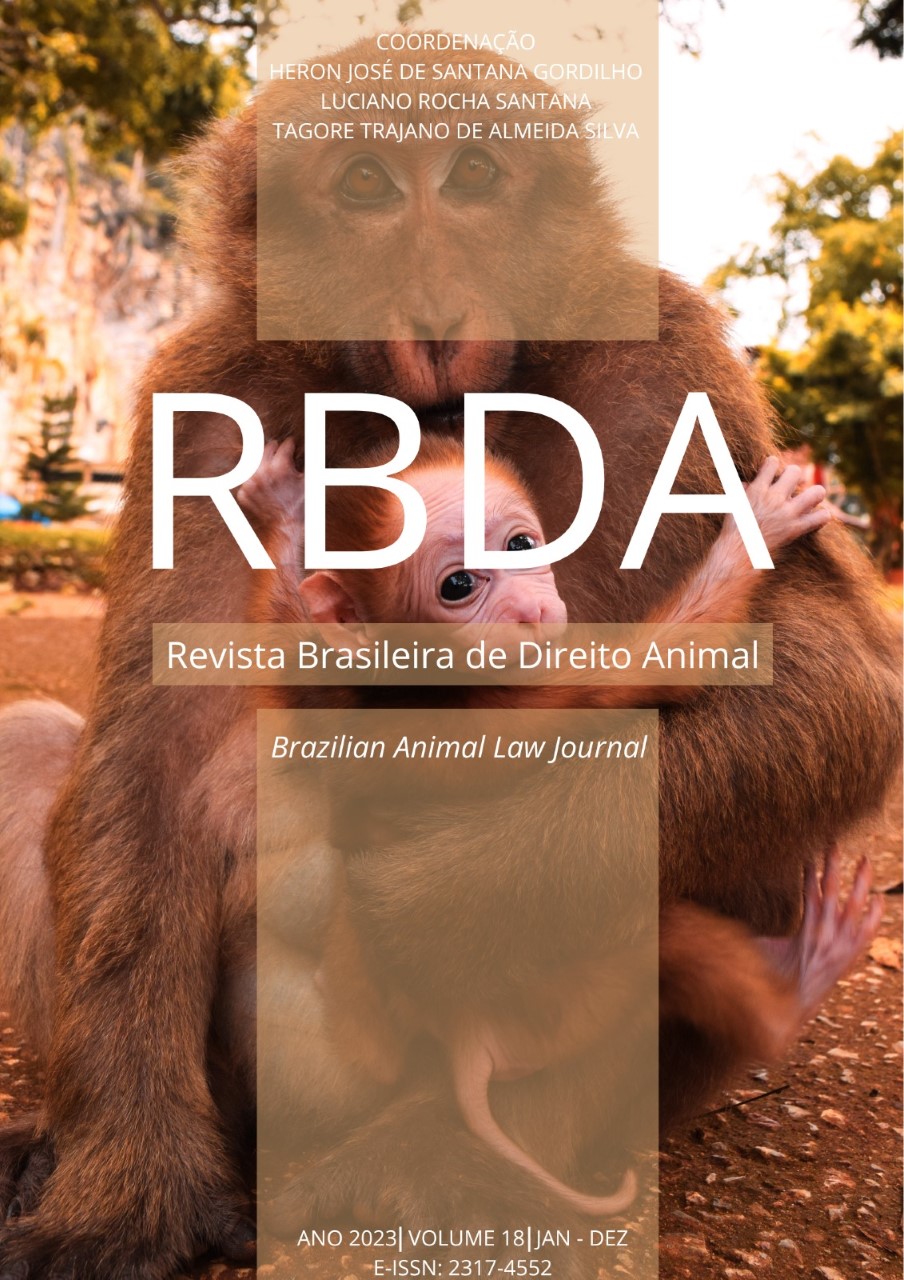Animal sacrifice in religious rituals: a reflection from the atheist and vegan universe
a reflection from the atheist and vegan universe
DOI:
https://doi.org/10.9771/rbda.v18i0.53704Keywords:
Animal sentience and suffering; Consequentialism; Religious and Animal rights; Virtue EthicsAbstract
In this article, based on bibliographical research, some moral and ethical aspects underlying the relationships between humans and animals are discussed in the light of Virtue Ethics and the consequentialist doctrine. According to this last theory, the result of our actions should guide human behavior, because what matters to those affected by them are their consequences. On the other hand, Virtue Ethics focus on the value of the intentions that guide such actions, not their consequences. However, the values that guide behaviors considered ethically correct can be arbitrary. Despite the demonstration of traditional moral virtues, there are practices supported by religions and cultural relativism that cause harm and death, without the consent of the victims. Furthermore, 'good intentions' are not enough for practitioners to manifest compassion towards the suffering of their victims, whether they are human or not. As science proves that several vertebrate and invertebrate animals are sentient beings, some even self-conscious, their use, exploitation, suffering and death become morally condemnable. For these ethical and scientific reasons, veganism preaches the abolition of the use of animals in any context. Human morality is the result of Evolution, and religions can even be harmful when it comes to consolidating ethically correct behavior. Thus, within a vegan and atheist perspective, we preach the abolition of any religious practices or rituals that use animals, regardless of whether they are killed, since there are no ethical or moral justifications to make such an exception.
Downloads
References
Algumas referências foram removidas para o blind review
ACADEMIA DE CIÊNCIAS DO ESTADO DE SÃO PAULO (ACIESP). Glossário de Ecologia. 1. ed. São Paulo, 1987. (Publicação nº 57)
ANDRADE, Sergio. Ípsilon. Cronologia: as polémicas de José Saramago (actualizada).18jun.2010. Disponível em:https://www.publico.pt/2010/06/18/culturaipsilon/noticia/cronologia-as-polemicas-de-jose-saramago-actualizada-1442502.Acesso em: 03 mar.2023.
BALCOMBE, Jonathan. Second nature: the inner lives of animals. New York: Palgrave Macmillan, 2010.
BARRON, Andrew B.;KLEIN, Colin. What insects can tell us about the origins of consciousness. PNAS,v.113, n. 18, p. 4900-4908, May 3, 2016. Disponível em: https://www.pnas.org/doi/10.1073/pnas.1520084113.Acesso em: 11mar. 2023.
BEKOFF, Marc. The emotional lives of animals: a leading scientist explores animal joy, sorrow, and empathy – and why they matter. Novato, CA: New World Library, 2007.
CÂMARA DOS DEPUTADOS. Comissão de Direitos Humanos, Minorias e Igualdade Racial. STF decide que sacrifício de animais é constitucional; CDHM apoiou movimentos sociais junto ao Tribunal. 19 mar. 2019. Disponível em: https://www2.camara.leg.br/atividade-legislativa/comissoes/comissoes-permanentes/cdhm/noticias/stf-decide-que-sacrificio-de-animais-e-constitucional-cdhm-apoiou-movimentos-sociais-junto-ao-tribunal.Acesso em: 05 mar 2023.
DAWKINS, Richard. Lagunas en la mente. In: CAVALIERI, P.; SINGER, P. El proyectogran simio: la igualdad más allá de la humanidad. Madrid: Editorial Trotta, 1998. p.105–114.
DAWKINS, Richard. The God delusion. First Mariner Books, 2008.
DE WAAL, Frans. Are we smart enough to know how smart animals are?London: GrantaBooks, 2017.
DIAMOND, Jared. El tercer chimpancé. In: CAVALIERI, P.; SINGER, P. El proyecto gran simio: la igualdad más allá de la humanidad. Madrid: Editorial Trotta, 1998. p. 115-132.
INSTITUTO HUMANITAS UNISINOS.Uma década depois. Vaticano faz as pazes com Saramago através da pandemia. 27 jun. 2020. Disponível em: https://www.ihu.unisinos.br/categorias/600391-uma-decada-depois-vaticano-faz-as-pazes-com-saramago-atraves-da-pandemia. Acesso em: 10mar. 2023
FRANCIONE, Gary. Personidad, propiedad y capacidad legal. In: CAVALIERI, P.; SINGER, Peter. El proyecto gran simio: la igualdad más allá de la humanidad. Madrid: Editorial Trotta, 1998. p.309–320.
CHAGDUD GONPA. Odsal Ling. Centro de Budismo Tibetano. 2019. Disponível em: https://www.odsalling.org/midiateca/oferenda-de-tsog/. Acesso em: 15 fev. 2023.
SINGER, Isaac Bashevis. The Slaughterer.The New Yorker,Fiction, 25 Nov. 1967.Tradução de Mirra Ginsberg. Disponível em: https://www.newyorker.com/magazine/1967/11/25/the-slaughterer. Acesso em: 12 mar.2023
SINGER, Isaac Bashevis. The Slaughterer. In: The Séance and Other Stories. New York: Farrar, Straus&Giroux, 1968. Disponível emhttps://www.sas.upenn.edu/~cavitch/pdf-library/Singer_Slaughterer.pdf. Acesso em: 11mar. 2023
GONÇALVES, Carlos Walter P. Possibilidades e limites da ciência e da técnica diante da questão ambiental. Geosul, Florianópolis, Ed. UFSC, ano III, n. 5, p. 7-40, 1º sem. 1988.
HERNANDEZ-LALLEMENT, Julen et al.Harm to others actsas a negative reinforcer in rats. CurrentBiology, v. 30, p. 949–961,23 mar. 2020.Disponível em: https://www.cell.com/current-biology/fulltext/S0960-9822(20)30017-8.Acessoem: 01mar.2023
SARAMAGO, José. O ‘Factor Deus’. LABORE: Laboratório de Estudos Contemporâneos; POLÊM!CA:Revista Eletrônica,v.9, n.4, 2010. Disponível em: https://www.e-publicacoes.uerj.br/index.php/polemica/article/view/2831/1958. Acesso em: 01mar.2023.
PARSONS, Miles J. G. et al.Fish choruses off Port Hedland, Western Australia. Bioacoustics: The International Journal of Animal Sound and its Recording, v. 26, n. 2, p.135–152, 2017. Disponível em: https://www.tandfonline.com/doi/full/10.1080/09524622.2016.1227940?ai=mv7m0&.Acessoem: 12 mar. 2023.
VALENTE, Cecilia de S. A ética senciocentrica e a exclusão de invertebrados da consideração moral. RJLB, ano 8, n. 2, p. 347–393, 2022. Disponível em: https://www.cidp.pt/revistas/rjlb/2022/2/2022_02_0347_0393.pdf.Acesso em: 3 mar. 2023.
SCHOPENHAUER, Arthur. Sobre o fundamento da moral. Tradução de Maria Lúcia Mello Oliveira Cacciola. São Paulo: Martins Fontes, 2001.
RYDER, Richard. All beings that feel pain deserve human rights. The Guardian, 6 ago. 2005. Disponível em: http://www.guardian.co.uk/uk/2005/aug/06/animalwelfare.Acesso em: 4 set. 2022.
RYDER, Richard. Speciesism, painism and happiness: a morality for the twenty-first century. Exeter, Charlottesville: Societas, 2011.
THE CAMBRIDGE Declaration on Consciousness. July 2012. Disponível em: https://fcmconference.org/img/CambridgeDeclarationOnConsciousness.pdf.Acesso em: 11mar. 2023.
UOL NOTÍCIAS. Lagostas e polvos sentem dor e não devem ser cozidos vivos, diz relatório. 23 nov. 2021. Disponível em: https://noticias.uol.com.br/internacional/ultimas-noticias/2021/11/23/cozidos-vivos-em-receitas-lagostas-e-caranguejos-sentem-dor-diz-estudo.htm.Acesso em: 12 mar. 2023.
WILKS, Jessica. Animal rights and the 19th century antivivisection: was Charles Darwin the catalyst? Nov. 2011. Disponível em: https://makinghistoryatmacquarie.wordpress.com/2011/11/22/animal-rights-and-19th-century-antivivisection-was-charles-darwin-the-catalyst/.Acesso em: 10 mar. 2023.
VON UEXKÜLL, Jakob. A Foray into the worlds of animals and humans. With a theory of meaning. Posthumanties 12. Cary Wolfe, Series Editor. Minneapolis, MN: University of Minnesota Press, 2010.
GOODALL, Jane. Reason for hope: a spiritual journey. New York; Boston: Grand Central Publishing, 1999.
KINGSFORD, A. Unscientific science: moral aspects of vivisection. [20--?]b. Disponível em:http://www.humanitarismo.com.br/annakingsford/english/Other_Related_Works/Texts/OOR-I-Spirit/OOR-I-Spirit-015.htm.Acesso em: 12mar. 2023.
KINGSFORD, A. “Violationism” or Sorcery in Science. TheosophicalSiftings, v. 3, [20--?]a. Disponível em: http://hpb.narod.ru/ViolationismOrSorceryInScienceAK.html
Acesso em: 12 mar. 2023.
REGAN, Tom. Ganancias mal adquiridas. In: CAVALIERI, P.; SINGER, P. El proyecto gran simio: la igualdad más allá de la humanidad. Madrid: Editorial Trotta, 1998. p.243-256.
Downloads
Published
How to Cite
Issue
Section
License
Copyright (c) 2023 Brazilian Animal Law Journal

This work is licensed under a Creative Commons Attribution-NonCommercial 4.0 International License.
1. Autores mantém os direitos autorais e concedem à revista o direito de primeira publicação, com o trabalho simultaneamente licenciado sob a Licença Creative Commons Atribuição 4.0 Internacional que permite o compartilhamentodo trabalho com reconhecimento da autoria e publicação inicial nesta revista.
2. Autores têm autorização para assumir contratos adicionais separadamente, para distribuição não-exclusiva da versão do trabalho publicada nesta revista (ex.: publicar em repositório institucional ou como capítulo de livro), com reconhecimento de autoria e publicação inicial nesta revista.
3. Autores têm permissão e são estimulados a publicar e distribuir seu trabalho online (ex.: em repositórios institucionais ou na sua página pessoal) a qualquer ponto antes ou durante o processo editorial, já que isso pode gerar alterações produtivas, bem como aumentar o impacto e a citação do trabalho publicado.












